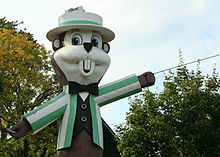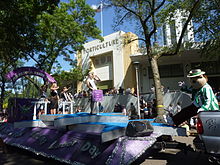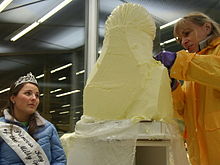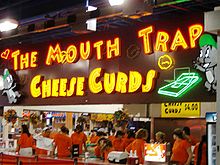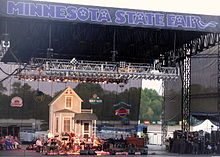- Minnesota State Fair
-
Coordinates: 44°59′8.79″N 93°10′6.37″W / 44.985775°N 93.1684361°W
Minnesota State Fair 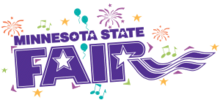
The State Fair Gopher 'Fairchild' greets fairgoers.Date(s) 12 days before and including Labor Day Location(s) Falcon Heights, Minnesota Years active 1859 - Present
(excluding 1861, 1862, 1893, 1945, 1946)Attendance 1,769,872 (2011) Genre State fair Website http://www.mnstatefair.org/ The Minnesota State Fair is the state fair of the U.S. state of Minnesota. Its slogan is "The Great Minnesota Get-Together." It is the 2nd largest fair in the United States,[1] and the largest state fair in the United States in terms of average daily attendance,[2] though the State Fair of Texas runs twice as long and is the largest by annual attendance.[3] It is held at the state fairgrounds, adjoining the Saint Paul campus of the University of Minnesota. The site is in the suburb of Falcon Heights, Minnesota, midway between the state's capital city of St. Paul and the largest city, Minneapolis. Residents of the state and region come to the fair to be entertained, exhibit their best livestock, show off their abilities in a variety of fields including art and cooking, learn about new products and services, and enjoy many different types of food—often on a stick. It runs for twelve days, running from late August into early September with the last day being Labor Day. In 2009, attendance was 1,790,497, equivalent to about 34% of the state's population. This was up almost 100,000 from the previous year. In 2010, however, total attendance dipped 14,000 people to 1,776,211 despite setting daily attendance records on three days.[4]
Contents
History
Minnesota Territory first held a Territorial Fair in 1854, although the first Minnesota State Fair didn't occur until 1859, the year after statehood. Since then, the fair has run annually except for five different years. In 1861 and 1862, the fair was not held because of the Civil War and the Dakota War of 1862. Scheduling issues between the fair and the World's Columbian Exposition in Chicago, Illinois caused the 1893 show to be canceled. The fair again closed because of war in 1945, as fuel was in short supply. It was again closed in 1946 because of an outbreak of polio.[5] In its early years during the 19th century, the fair was held in many different locations. Some were not far from the current site, but others were relatively far-flung, including years where it was held in Rochester, Owatonna, and Winona. For a time in the 1870s, the Twin Cities of Minneapolis and St. Paul held competing fairs. Minneapolis, the younger city of the pair, eventually outdid its neighbor by staging the larger fair with the help of William S. King.[6] In 1884, a committee was put together by the Minnesota State Agricultural Society to select a permanent site. One site that was considered was an area around Minnehaha Falls, but the final site chosen was the Ramsey County Poor Farm, the fair's current site. It was a politically-neutral site, being about halfway between Minneapolis and St. Paul. The fair first opened its doors there on September 7, 1885. The site was then 210 acres (0.8 km²), but now stands at 320 acres (1.3 km²).
One of the first annual events to occur is the creation of a butter sculpture. Each year, a new Princess Kay of the Milky Way is selected to promote Minnesota's dairy industry. Part of the job involves posing for several hours in a walk-in, glass-walled refrigerator as a 90 pound (41 kg) block of butter is carved into a head with her likeness. Butter makers started sculpting their products at the fair as far back as 1898, although the head-sculpting tradition didn't begin until 1964.
The main entrance to the fair from Snelling Avenue heads onto a road named Dan Patch Avenue for a pacer horse who won every race he ran in from 1900 to 1909 when he was retired.
One of the most significant dates in the fair's history was September 2, 1901 when then-Vice President Theodore Roosevelt was visiting and first uttered the famous phrase, "Speak softly and carry a big stick." Roosevelt became president just 12 days later after William McKinley was assassinated. In 1925, the Minnesota State Fair was the site of the Norse-American Centennial celebration. During his appearance at the Norse-American Centennial, President Calvin Coolidge gave recognition to the contributions of Scandinavian-Americans and noted Leif Erikson as the discoverer of America.[7]
Attractions
Livestock departments
A large portion of the Fairgrounds are occupied by livestock barns, where various farm animals are displayed. The animals and their owners take part in livestock shows to compete for awards. Most of the shows take place in the coliseum, a large indoor arena on the fairgrounds. Open class livestock competitions are held in horses, beef cattle, dairy cattle, swine, sheep, dairy goats, llamas, poultry (chickens, ducks, geese, turkeys, pigeons) rabbits, and stock dogs.[8] On August 31, 2007, a bull escaped from its handler charging several fairgoers before charging a fire hydrant reaching its demise. No people were seriously injured in the mishap.[9]
Food
One of the primary attractions at the State Fair is the wide variety of foods to be had. Classic fair foods such as cotton candy and hot dogs are readily available. Many foods reflect Minnesota's agriculture; cheese curds, milk shakes, and corn dogs are popular favorites. Many foods at the fair are deep fried or come on a stick; from the classic corn dog to alligator-on-a-stick, lobster-on-a-stick, deep fried candy bar on a stick, and even "beer-on-a-stick". New to the fair in 2006 was hotdish on a stick, a variant of a classic staple of Minnesotan cuisine. In 2007 the new food was spaghetti on a stick. 2008's new foods were two types of bacon, one called "Pig Lickers", which is chocolate covered, and the other, called the "Big Fat Bacon", a quarter pound of maple glazed bacon.[10]
Machinery Hill
Machinery Hill is a large area of the fairgrounds. For several decades, it held the largest annual display of farm equipment in the world, with many companies showing off tractors, combines, and various attachments. However, modern displays generally focus on cars, trucks, lawn mowers, and recreational machines like motorbikes. Farm implement dealers tend to direct their efforts to more targeted "farm shows," abandoning the State Fair to more urban or suburban types of exhibitors.
Shows
The State Fair is host to numerous shows, including concerts, comedy shows, product demonstrations, and the State Fair Talent Contest. The Grandstand is a large outdoor concert hall that also features 3 floors of interior exhibition space. It hosts the largest of the fairs concerts and until 2002 was also the site of stock car races run on a small oval track. In 2003 the facility completed the first phase of a $35 million remodeling project that removed large sections of bleachers and increased seating capacity to 17,000.[11] Local television and radio stations will normally set up temporary studios at the State Fair, and one of the most popular events is the live broadcast of Garrison Keillor's A Prairie Home Companion.
Art
The fair displays an annual art exhibition that is the result of a juried competition of works of fine art. Media include watercolor, oil, and acrylic paintings, photographs, sculptures, pastels, ceramics, glass, and textiles. Entrants must be living residents of the state. In 2010, a total of 2,330 pieces were submitted, and 413 works were accepted. Jeffery Gauss won the coveted People's Choice award with his "MicroDoodle Topiary", and "Dog Park" by Arden Harrison Bushnell won the Kid's Choice award. http://www.mnstatefair.org/competition/fine_arts_winners.html 2011 marks the 100th year of Fine Arts at the Fair. http://www.mnstatefair.org/competition/fine_arts.html[12]
One unusual display at the fair consists of the entrants in the Crop art competition. The artwork must be made of plant matter (seeds, stems, flowers, fruit, etc.) suitable for growing in Minnesota.[13] For decades the display was dominated by Owatonna native Lillian Colton (1912–2007), who created seed portraits, professionally,[14] having effectively captured scores of celebrities such as Ernest Hemingway, Barbra Streisand, Franklin D. Roosevelt, Prince, Princess Diana, and Willie Nelson in her crop art. After winning nine purple ribbons, she stopped competing, but continued displaying her work at the fair.[15]
Competitions galore cover dozens of categories in needlecraft, garment-making, wood-working, models, painting, doll-making, taxidermy, stamp-collecting, scrapbooking, baking, food preservation, etc.[16]
Milk run
The annual 5 km run begins on the fairgrounds, winds its way through the Saint Paul campus of the University of Minnesota (both in Falcon Heights) and the Saint Anthony Park neighborhood, and ends back at the fairgrounds.[17]
4-H
4-H[18] has a significant presence at the fair, both in their own building and in the livestock areas. Contests include herdsmanship, showmanship, judging teams, public presentations, non-livestock exhibits, and county club exhibits. Livestock displays include beef and dairy cattle, dairy and market goats, poultry (chickens, ducks, geese, turkeys, and pigeons), rabbits, sheep, and swine.[19] During the 2009 State Fair four students fell ill with the H1N1 influenza virus (all recovered), and as a precaution, hundreds of other 4-Hers were evacuated from the 4-H dormitories on the grounds.
Science
In recent years the science building has been housing the Eco Experience exhibit, which features activities and exhibits including the design and construction of an eco-friendly house, a rain garden, exhibits addressing climate change, energy conservation, renewable energy, biodiesel fuel and vehicles, and organic farming. The exhibit has received awards from the Western Fair Association, the International Associate of Fairs and Expositions, and the Minnesota Environmental Initiative.[20]
Entertainment
Music
Every year there are many musical venues. The most notable venue being the Grandstand which have featured performers such as REO Speedwagon, Boston, Christina Aguilera, Backstreet Boys, Def Leppard, Styx, Foreigner, Bob Dylan, Santana, Lynyrd Skynyrd, Carrie Underwood, Sons of Sylvia, Craig Morgan, Tim McGraw, Rush, KISS & "Weird Al" Yankovic, among others.
There are also many free entertainment venues from local bands and a selection of national acts. In 2010, Boyz II Men performed 2 nights at one of the free venues.
Rides
Permanent rides
There are several rides that are permanent fixtures at the fair. The most popular of these is the Giant Slide, on which fairgoers ride down a large metal slide on burlap sacks. The Skyride is an aerial lift ride that carried fairgoers across the grounds in a gondola. The Space Tower is a gyro tower that rotates as it lifts people over 300 feet in the air, giving spectacular views of the entire Minneapolis/St. Paul area. The Haunted House, located on Judson Ave. is another favorite of fairgoers. Further down the block is a water raft ride. The log chute is another popular thrill ride. The fair's oldest ride, Ye Old Mill, is located near the food building. It is a tunnel of love style ride that caters to all ages.
Temporary rides
The Midway is a carnival-like setting that contains most of the rides at the State Fair. The attractions include several funhouses, roller coasters and other thrill rides as well as numerous games of skill.
Adventure Park is where the extreme thrill rides are located. This includes the Ejection Seat and other rides like it. It is located across the street from the Midway, but is not a part of it. Adventure park also shares this block with a french fry stand, which is a crowd favorite.
Kidway is the carnival area on the fairgrounds geared toward children. Kidway is located between Dan Patch and Wright Avenues on the north end of the fairgrounds.
Management
The Minnesota State Fair is considered a quasi-state agency, under the direction of the Minnesota State Agricultural Society. The management of the fair is handled by the Board of managers. The state fair has not accepted any governmental funds since 1949. Revenue from the fair is reinvested into maintenance and the next year's fair.
The Minnesota State Fair Foundation is an organization that works to improve and preserve historic state fair buildings. The foundation is a 501(c)3 organization, and also supports State Fair agricultural, scientific and educational programs. The foundation provided funding for the new Miracle of Birth center.
J.V. Bailey House
The J.V. Bailey House, at 1263 Cosgrove Street, is one of the oldest buildings on the fairgrounds. It was built in 1911 and restoration was completed in 2006. It is connected to the greenhouses and was used as the greenhouse superintendent's quarters. The State Fair Foundation operates it as a historic site open to the public during the fair.[21]
Mascots
The fair's mascots are two anthropomorphized gophers. The original mascot was named by Gladys Anderson Brown for Henry S. Fairchild who advocated using the former Ramsey County Poor Farm as the permanent site of the fair. Dressed like an early barker on the midway with a straw hat and striped jacket, Fairchild has represented the fair for decades. In 1986, he was joined on promotional materials by his nephew, Fairborn.[22]
Attendance records
Day Attendance[5] Year First Thursday 119,145 2010 First Friday 132,738 2010 First Saturday 202,126 1998 First Sunday 209,969 1994 First Monday 143,998 1994 First Tuesday 129,423 2009 First Wednesday 128,966 2006 Second Thursday 155,183 1995 Second Friday 179,052 2003 Second Saturday 234,384 2010 Second Sunday 229,943 2011 Second Monday (Labor Day) 160,209 2006 Entire Fair 1,790,497 2009 Off-season use
The fairgrounds is heavily used during the off-season (non-fair time) for non-profit and commercial events. These include many horse shows in the Coliseum & Horse Barn (and a Deer Show), the Minnesota Horse Expo and the Minnesota Beef Expo, dog shows, antique & hot-rod car shows, motorcycle shows, model railroad shows, clothing & jewellery shows, gun & weapon collectors shows, comic book conventions, flea markets & swap meets, ice hockey games in the Coliseum, and more. Buildings on the grounds are frequently rented for commercial events such as appliance sales, computer & electronics sales, and boat & car sales.
In addition, many of the buildings are rented for winter storage of boats, camping trailers, and similar equipment.
Rental fees for such off-season use of the fairgrounds is a major source of revenue for the State Fair, often surpassing the profits from the Fair itself.
Gallery
-
Audrey Mohr of New Ulm, Minnesota (right), Princess Kay of the Milky Way 2006-2007
-
Jams, jellies and honeys
-
Golden Gopher Spirit Squads during the Maroon and Gold Day Parade in 2003
External links
References
- ^ http://www.carnivalwarehouse.com/lists/2010list.pdf
- ^ "2006 Detailed Daily Attendance". Minnesota State Fair. http://www.mnstatefair.org/pages/attendance.html. Retrieved 2007-07-17.
- ^ "Fiscal Notes, September 2003". Texas Comptroller of Public Accounts. September 2003. http://www.window.state.tx.us/comptrol/fnotes/fn0309/big.html. Retrieved 2007-07-17.
- ^ "2006-2008 Detailed Daily Attendance". http://www.mnstatefair.org/pages/attendance.html. Retrieved 2009-11-22.
- ^ a b "Minnesota state fair 2006 press kit" (PDF) (Press release). Minnesota state fair. 2006. http://www.mnstatefair.org/2006_pdf/PressKit_MSF2006.pdf. Retrieved 2007-08-06.
- ^ Marling, Karal Ann (1990). Blue Ribbon: A Social and Pictorial History of the Minnesota State Fair. Minnesota Historical Society Press. ISBN 978-0873512527.
- ^ The 1925 Norse-American Immigration Centennial and Ethnic Identity (April Schultz. Norwegian-American Historical Association. Volume 33: Page 267)
- ^ "Open Class Livestock". Minnesota State Fair. 2007. http://www.mnstatefair.org/pages/livestock.html. Retrieved 2007-07-17.
- ^ "Bull Escapes At Minnesota State Fair". WCCO. 2007-08-31. Archived from the original on 2007-09-29. http://web.archive.org/web/20070929100000/http://wcco.com/local/local_story_243124851.html. Retrieved 2007-08-31.
- ^ "new tastes, their takes". twincities.com (St. Paul Pioneer Press): pp. 10E. 2008-08-28.
- ^ Cunningham, Greta (2003-08-18). "State Fair Grandstand to get a facelift". Minnesota Public Radio. http://news.minnesota.publicradio.org/features/2003/08/18_cunninghamg_grandstand/. Retrieved 2006-09-30.
- ^ "Fine Arts". Minnesota State Fair. 2007. http://www.mnstatefair.org/pages/fine_arts.html. Retrieved 2007-07-17.
- ^ "Ag-Hort-Bee Rules and Premiums" (pdf). Minnesota State Fair. 2007. Archived from the original on 2007-09-28. http://web.archive.org/web/20070928083538/http://www.mnstatefair.org/2007_pdf/AG07-pbWeb.pdf. Retrieved 2007-07-17.
- ^ "A remembrance of the Seed Lady". MPR. 2007-03-22. http://minnesota.publicradio.org/display/web/2007/03/22/seedladyobit/. Retrieved 2007-07-17.
- ^ "Crop Art". David Steinlicht. http://www.cropart.com/index.htm. Retrieved 2007-07-17.
- ^ "Creative Activities - Rules and Premiums" (pdf). Minnesota State Fair. 2007. Archived from the original on 2007-09-28. http://web.archive.org/web/20070928083546/http://www.mnstatefair.org/2007_pdf/CA07-pbWeb.pdf. Retrieved 2007-07-17.
- ^ "Milk Run". Minnesota State Fair. 2007. http://www.mnstatefair.org/pages/milk_run.html. Retrieved 2007-07-17.
- ^ "Minnesota State 4-H". Minnesota State 4-H. 2007. http://www.fourh.umn.edu. Retrieved 2007-08-28.
- ^ "4-H Livestock". Minnesota State Fair. 2007. http://www.mnstatefair.org/pages/4_H.html. Retrieved 2007-07-17.
- ^ "The Eco Experience at the Minnesota State Fair". Minnesota Pollution Control Agency. 2007. http://www.pca.state.mn.us/ecoexperience/. Retrieved 2007-07-17.
- ^ "J.V. Bailey House". Placeography.com. http://www.placeography.org/index.php?title=J.V._Bailey_House%2C_1263_Cosgrove_Street%2C_Saint_Paul%2C_Minnesota. Retrieved 2008-08-29.
- ^ Marling, Karal Ann (1990). Blue Ribbon: A Social and Pictorial History of the Minnesota State Fair. St. Paul, Minnesota: Minnesota Historical Society Press. p. 234. ISBN 978-0873512527.
Categories:- History of Minnesota
- Minnesota culture
- State fairs
- Festivals in Minnesota
- August events
- September events
- Recurring events established in 1859
- Visitor attractions in Ramsey County, Minnesota
- Buildings and structures in Ramsey County, Minnesota
-
Wikimedia Foundation. 2010.

